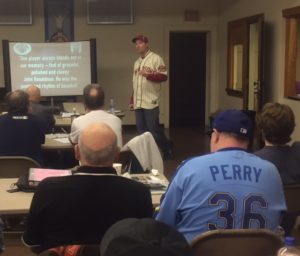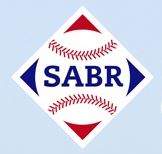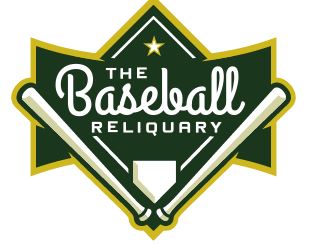First Published in November 2016, career statistics updated in 2021.
Leroy “Satchel’ Paige – Bullet Joe Rogan – Bob Gibson – Fergie Jenkins – Smokey Joe Williams – John Wesley “Cannon Ball” Donaldson. Six great Black hurlers, who all brought lightening to the mound. Six ferocious competitors who could strike fear in the hearts and minds of batters. Six moundsmen who drew crowds and piled up strikeouts at an impressive pace. Six pitchers consistently discussed as among the best of their time by those who took the field against them. FIVE members of the Baseball Hall of Fame.
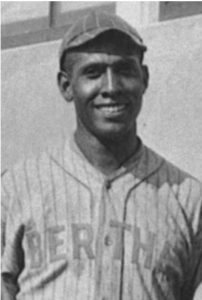
John Wesley Donaldson
Photo: Courtesy of Bertha (MN) Historical Society and The Donaldson Network.
In this post, I’d like to take a look at the career of the only one of the above-mentioned pitchers not in the Baseball Hall of Fame – John Donaldson – but whose legacy is clearly Hall of Fame worthy. I should add that this reflection would not be possible without the years of research conducted by Peter Gorton and The Donaldson Network – an organization dedicated to generating the recognition (and Hall of Fame plaque) that Donaldson deserves. The article was, in fact, prompted by a recent presentation Gorton made before the Halsey Hall Chapter of the Society for American Baseball Research. For even more information, I suggest you visit The Donaldson Network’s page at johndonaldson.bravehost.com or (after reading this post, of course) click here.
DONALDSON FANS SIXTEEN MAJOR LEAGUERS
The date was December 9, 1917 and the Los Angeles White Sox were facing the California Winter League defending Champion San Pedro Merchants in San Pedro. (BBRT note: The California Winter League is generally recognized as the first U.S. integrated league in the 20th Century. The teams themselves were not integrated, but all-Black teams were included in the league.)
On the mound for the LA Team was John Wesley “Cannonball” Donaldson, star hurler from the barnstorming All Nations squad – considered by many to be “the greatest colored pitcher of his time.” Starting for San Pedro was Pete Schendler – a 20-game winner for the Cincinnati Reds during the 1917 National League season. The San Pedro lineup, in fact, was made up of all major leaguers.
The Los Angeles squad emerged as 5-3 victors. Of even more significance is the performance of Donaldson against San Pedro’s all-white, all-major league squad. Donaldson pitched a complete-game, six-hitter, fanning sixteen batters.
John Donaldson was a well-traveled practitioner of the baseball arts. His playing career touched four decades (1908-1941) and he wore the uniforms of at least 25 teams and took the mound on more than 550 ball fields. Donaldson’s collection of home jerseys stretched from coast-to-coast and in between – Brooklyn Royal Giants, Chicago American Giants, Kansas City Monarchs, Los Angeles White Sox. Here in BBRT’s home state of Minnesota, Donaldson twirled his mound magic for teams in Bertha, Lismore, Madison, Melrose, Arlington and St. Cloud. He also starred internationally, pitching for several Canadian squads.
Over his 34-year career, Donaldson pitched pretty much wherever he could draw a crowd and a paycheck and against pretty much anyone willing to step in the batter’s box and face him. The Donaldson Network has documented 422 victories and 5,177 strikeouts for the lean and limber Donaldson – as well as 14 no-hitters, two perfect games and more than two dozen games of 20 or more strikeouts. But, I’m getting ahead of myself.
John Wesley Donaldson was born February 20, 1891 in Glasgow, Missouri. It’s reported that he was a good student and a superb athlete. (Donaldson graduated from the integrated Evans High School with honors and attended George Smith College in Sedalia, Missouri before deciding to concentrate on baseball.) He began pitching in grade school and, as a sixth-grader, led his school’s team to the regional championship.
As a teenager, Donaldson pitched for the Missouri Black Tigers (Higbee, MO) in 1908 and the Hannaca Blues (Glasgow) in 1909-1910. Donaldson, however, really began building his reputation as the “greatest colored pitcher of his time” when he left college and joined the Black barnstorming Brown’s Tennessee Rats in 1911. During that season, Donaldson won 41 games against just three losses – foreshadowing a long and successful career on the mound.
JOHN DONALDSON GOES 18 INNINGS – FANS 31
On September 14, 1911, John Donaldson took the mound for the barnstorming Brown’s Tennessee Rats versus a team from Humboldt, Iowa. The Rats won 4-3 in 18 innings, with Donaldson tossing a complete game, fanning 31 batters and giving up no hits after the sixth inning. BBRT note: Just three days later, in LeHigh, Iowa, Donaldson pitched a complete-game, 19-strikeout, shutout.
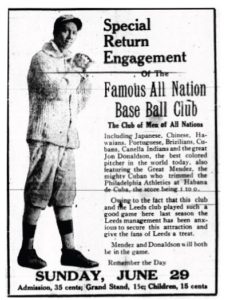 In 1912, Donaldson moved to the All Nations multi-racial team operated by future Hall of Fame baseball executive J.L. Wilkinson. The All Nations team – composed of Black, White, Native American, Latino, Hawaiian and Asian players – was one of the country’s most successful barnstorming clubs. Donaldson proved one of the most dominant pitchers in the game while with the All Nations squad. In his first two seasons, he won eighty games, while losing only five – consistently racking up double-digit strikeout totals.
In 1912, Donaldson moved to the All Nations multi-racial team operated by future Hall of Fame baseball executive J.L. Wilkinson. The All Nations team – composed of Black, White, Native American, Latino, Hawaiian and Asian players – was one of the country’s most successful barnstorming clubs. Donaldson proved one of the most dominant pitchers in the game while with the All Nations squad. In his first two seasons, he won eighty games, while losing only five – consistently racking up double-digit strikeout totals.
Baseball Hall of Fame (enshrined in 2006) executive/entrepreneur J.L. Wilkinson termed John Donaldson, “One of the greatest pitchers that ever lived – white or black.”
The year 1917 was a notable one for Donaldson. It was the year the major leagues came calling. Reports show that Donaldson was offered $10,000 to travel to Cuba, change his name and return to the U.S. to play big league ball as a Cuban. The major league offer required him to renounce his family and all association with “colored” people in order to maintain his “Cuban” identity. Donaldson flatly refused the offer and, with that refusal, lost his only shot at the all-white hallowed fields of the major leagues. That same year, the impact of World War I reached America. The baseball season closed and the All Nations team was dissolved. Pressure from the looming Railway Control Act grounded the ability of barnstorming clubs to travel. For the next few years, Donaldson’s career “settled” and he enjoyed “home field advantage” for the first time since his teenage years (although with a number of different established clubs.)
Just as Donaldson’s on-field life settled in 1917, he settled in off the field as well – marrying Eleanor Watson of Minneapolis, Minnesota. Donaldson’s marriage lasted until his death in 1970 and had an impact on both his baseball career and Minnesota’s baseball history.
Donaldson’s next contracts were signed with a series of top-notch All-Black teams including the Brooklyn Royal Giants, New York Lincoln Giants, Indianapolis ABC’s and Detroit Stars. When the Negro League was officially formed in 1920, Donaldson was again paired with his old boss, J.L. Wilkinson, who signed him for the Kansas City Monarchs. Donaldson would become one of the best center fielders in the league. He anchored the Monarchs with his five-tool ability, pitching less and presiding over a club that would become the most successful franchise in the history of Negro League baseball. During his tenure with the Monarchs (1920-23), Donaldson also played for and managed the revived All Nations barnstorming team, now traveling by automobile.
In 1924, Donaldson returned to his wife Eleanor’s home state of Minnesota – signing a contract with the semi-pro Bertha Fisherman for the princely sum of $325 per month. (BBRT note: It is reported the Donaldson received $1,478 for his season’s work – $18 more than the combined salary for the rest of the Bertha squad.) It was a solid investment, as the team won games, drew large crowds and turned a profit behind Donaldson’s electrifying left arm. For the season, the team (Central and Northwest Minnesota Champions) went 21-5 (with one tie). Donaldson’s record was 21-3 (yes, he recorded all 21 Bertha victories), and he struck out 325 batters in 211 innings. Donaldson also led the team with a .439 batting average.
MINNESOTA PRIDE
Minnesotans should take special pride in John Donaldson’s accomplishments. He played for or against teams in more than 130 towns and cities across the state. Approximately 150 of Donaldson’s documented victories were recorded on Minnesota ball fields, as were approximately 1,900 of his documented strikeouts. Segregation in the major leagues forced Donaldson to seek baseball stardom in the Gopher State and Minnesota benefited.
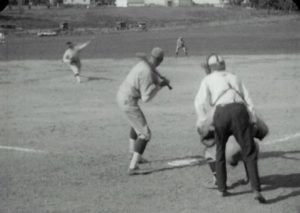
Video of John Donaldson. Courtesty of W.T. Oxley and the Donaldson Network. TO VIEW VIDEO, CLICK http://Vimeo.com/173608869
Donaldson followed up with a stellar season for Bertha in 1925, before moving on to the Lismore (MN) Gophers in 1926. Lismore signed the profitable lefty for $450 a month, the use of a furnished house and the opportunity to pick up extra money pitching for other teams on off-days. Not to be repetitious but – continuing to go where he could make the best living on the mound – from 1928 to 30, Donaldson racked up wins and strikeouts for teams in towns like: Bertha; Melrose, Minnesota; Scobey, Montana; and St. Cloud, Minnesota; as well as for barnstorming squads like the Colored House of David.
In the early 1930’s, Donaldson – now entering his forties – played for such squads as his own John Donaldson All Stars (1931-33); The Kansas City Monarchs (1931 and 1934); Joe Green’s Chicago Giants (1934-37); and even Satchel Paige’s All Stars. Even as his career wound down, he continued to display the skills that had made him one of the most sought after ballplayers over the previous two decades.
JOHN DONALDSON RECORDS 23-STRIKEOUT GAME … AT AGE 43
On June 3, 1934 – the then 43-year-old John Donaldson – went to the mound for Joe Green’s Chicago Giants against the People’s Club in Rockford, Illinois. Donaldson threw a complete-game, one-hit shutout, fanning 23 batters on the way to a 3-0 win.
Just how good was John Donaldson? Here are comments from a few who saw him pitch:
- Hall of Fame shortstop and manager John Henry “Pop” Lloyd said Donaldson was the greatest pitcher he ever faced.
- Negro League ambassador Buck O’Neil said; “John Donaldson … showed Satchel (Paige) the way, and the fact is, there are many people who saw them both who say Donaldson was just as good as Satchel.”
- Hall of Famer manager John McGraw said “I think he is the greatest I have ever seen.”
A FEW OF JOHN DONALDSON’S DOCUMENTED ACCOMPLISHMENTS
- 422 victories
- 5,177 strikeouts
- 14 no-hitters; two perfect games
- A 31-strikeout game (18 innings)
- More than two dozen games of 20 or more strikeouts
- Three consecutive 500-strikeout seasons
*You can put an “at least” in front of all these statistics. These are just the victories and strikeouts documented thus far by The Donaldson Network.
While Donaldson clearly made history on the field, he is also credited with making it off the field. In 1949, the Chicago White Sox hired Donaldson as the first full-time African-American scout in the major leagues. The White Sox drew on Donaldson’s half-century of experience in segregated baseball to help connect the team to the untapped talent of the Negro Leagues and Black baseball.
PETE GORTON … AND THE DONALDSON NETWORK
BBRT note: Again, this post would not have been possible without the much appreciated past efforts and current assistance of Pete Gorton and the resources of The Donaldson Network.
Peter Gorton tells the John Donaldson story. at the Halsy Hall SABR Chapter meeting.
Pete Gorton is the founder of The Donaldson Network, which has collected contributions from more than 550 authors, researchers and historians in the rediscovery of the lost legacy of John Wesley Donaldson. Gorton, who lives in Minneapolis, is a speech consultant and member of the Society for American Baseball Research (SABR) Negro Leagues Committee. He has studied the career of John Donaldson for the past 15 years; and shared in the SABR/ Sporting News Research Award for his chapter on Donaldson in the book Swinging for the Fences: Black Baseball in Minnesota. He also received the 2006 Coates Memorial Award for outstanding research in the field of Black baseball and the 2011 Tweed Webb Lifetime Achievement Award (recognizing long-term contributions to the field of Negro League research).
The Center for Negro Leagues Baseball Research called The Donaldson Network: The most extensive research project that has ever been undertaken related to Black baseball.
___________________________________
EXCERPTS FROM BASEBALL ROUNDTABLES’ 2016 INTERVIEW WITH PETE GORTON:
1) What set you on this “Mission?”
I began looking into the story of John Donaldson in 2000 for a book my former high school Social Studies teacher was putting together. His project chronicled the history of Black baseball in Minnesota. I was a freelance television photographer at the time and had opportunities to dig into a story he pitched to me as a difficult challenge. He told me a couple of other established writers had turned it down because documenting John Donaldson’s story was “too difficult.”
I had a connection – sort of – to John Donaldson. My hometown of Staples is 13 miles from Bertha, Minnesota, where Donaldson played three seasons (1924-25 and 1927.) Growing up, I had never heard of him …. I was curious how such a great player could be so unknown.
I made an appointment to go to the Bertha Historical Society. When I visited, the curator at the time showed me their collection of scorebooks, photographs and scrapbooks. There was a broadside poster on the wall that advertised “JOHN DONALDSON – GREATEST COLORED PITCHER IN THE WORLD.” … I knew then I needed to keep on the story and figure out why people did not know his name.
I continued to look for every mention of Donaldson in papers everywhere I traveled and began amassing a file collection that I knew people would eventually want to see. Meanwhile the book Swinging for the Fences: Black Baseball in Minnesota came out and I had written the Donaldson chapter. This led to an invitation to attend a ceremony in Chicago. That invitation came from the Negro Leagues Baseball Grave Marker Project, who had discovered Donaldson was buried in an unmarked grave. They had raised funds, with a major contribution from Jerry Reinsdorf, owner of the White Sox, to have a marker designed and built to honor John Donaldson.
While attending the ceremony, I stood with some of the most renowned Negro League baseball historians in America. We stood over Donaldson’s final resting place and I asked “What do we really know about John Donaldson?” I figured someone must have put his story together. The answer was “not enough” and, at that moment, we started in earnest to document the remarkable career of John Donaldson.
The legacy of John Donaldson is an example of what happens when a great human being is marginalized by segregation: history forgets.
2) What do you see as John Donaldson’s most significant achievement?
In my opinion, John Donaldson’s most significant achievement was his ability to survive in the times in which he lived. I do not want to sound too melodramatic, but life for a black man in the early Twentieth Century was difficult. The average life expectancy for a black male in 1900 was 35 years.
Donaldson was born in February of 1891 in Glasgow, Missouri. Just a few weeks prior to having, her first child, Ida Donaldson endured the lynching of a Black man in the streets of Glasgow. Imagine being eight-months pregnant and having this atrocity take place in your city. Incredible! John Donaldson knew from a very early age what it took for a Black man to survive in the segregated world. He went on to do so many wonderful things despite a society that did not think he was worthy of anything significant. He was a great ballplayer, but his life is an extraordinary example of what it was like to be Black in America. He endured his father being murdered by a railroad cop in 1923. His ability to navigate the miles and play baseball in at least 25 states and over 550 cities meant he showed exceptional courage to merely survive.
So, I believe John Donaldson’s greatest achievement includes baseball, but baseball is not his most resounding contribution. Donaldson’s ability to excel on the field and survive off of it to become one of the all-time greatest ballplayers is his most significant contribution not just to baseball, but to society.
MISSOURI SPORTS HALL OF FAME NOMINATION
John Donaldson is a 2017 nominee for the Missouri Sports Hall of Fame due, in large part, to the work of The Donaldson Network.
3) What has been the most challenging aspect of the research?
The most challenging aspect of researching John Donaldson is the sheer amount of information we have been able to amass, yet people do not seem to easily grasp how significant he was.
We have nearly 6,000 newspaper articles that are relevant to the career of John Donaldson. As I sit here today, there are at least 250 more that have yet to be processed. Each gives further detail to a story that encapsulates what Negro League baseball was all about. From the beginning to the end of the segregated era, John Donaldson was in the middle of it all. The neglect of Donaldson’s legacy in the annals of not only Negro League baseball history, but the entirety of baseball history, is a glaring omission.
BBRT agrees, it is indeed time for John Donaldson to take his well-earned place in Cooperstown.
I tweet baseball @DavidBBRT
Member: Society for American Baseball Research (SABR); The Baseball Reliquary; Baseball Bloggers Alliance.
2016 MLB AWARDS POST
It’s baseball awards season. BBRT made its predictions for the major awards before the finalists were announced. For a look at whom BBRT likes and why, click here.
